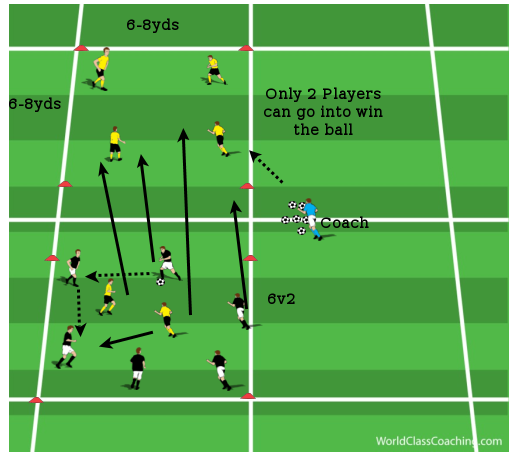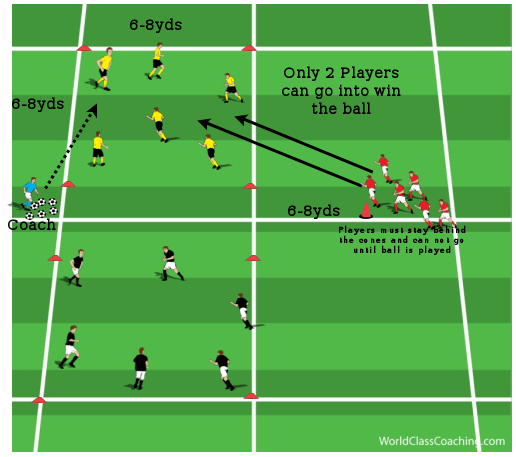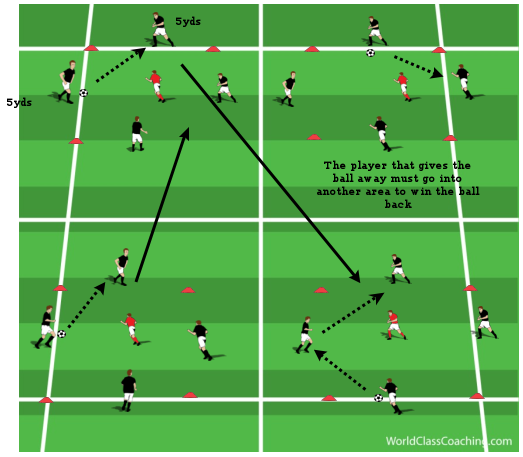By Sean Reed -
Within this session I have continued the theme of rondo’s with some additional options, using a different number of players.
Objective: Session 1
Exploiting the overload when in possession and switched on for the transition phase from in possession to out of possession

Set Up
- 2 Teams of 6 up wards.
- Set up into 2x boxes 6-8yds with a 5yd gap separating the 2 boxes
- Balls start with the Coach. Ball is played into one of the boxes, the team without the ball sends in 2 players to defend and to win the ball back
- The ball is then played from the coach into the other team (yellow), then players return to their box and 2 players from the other team look to win the ball
- 1) Unlimited of touches + Defenders need to just get a touch on the ball to stop them
- 2) Restricted touches + Defenders must clear the ball out of the area to stop them
- Passes are accumulative during the period of time and the highest total at the end of the 2mins wins the game
- If the defending players get into the opponents area, before the ball has been played (3 passes of their score)
- If 3 players instead of 2 enter the opposition area (3 passes of their score)
- Depending on the level if the defenders can win the ball and return to their own team to continue passing, then an extra 3 passes can be awarded.
- Defending players must stay on their feet
Coaching Points
- Movement and angles on the outside to support the ball
- Know the next pass
- Opening up to change the play
- Looking to get a bounce player in the middle to provide angles of support
- Quality of 1st touch and 2nd touch
- Speed of movement and tempo of passing
- Attitude and work rate of player in the middle
- Reaction during the transition phase
- Acceleration and deceleration applying pressure on the ball
- Defenders must stay on their feet
Objective: Session 2
3 Team Boxes

Set Up
- Working with 3 teams
- A Team in each of the 2 boxes, with 1 team standing next to the cone outside See Diagram 2
- The team outside will defend for the duration of time (90secs for example). Working in pairs they close the ball down to force a mistake
- The teams in the box are looking to make as many passes as possible.
- The ball will be played into 1 of the box, the defending team will send in 2 players to force a mistake. Once that has been a achieved, the coach will play a pass into the 2nd box, and 2 new defenders will look to win the ball
- Once the time has run out the teams will switch places.
- You can score either by the total number of mistakes forced or the least amount of passes accumulated by the teams keeping possession.
- You can change up the rules, similar to the 1st session with unlimited touches and a touch to stop it and restricted touches and the defenders must clear the ball from the grid.
Coaching Points
- As within the previous session
- Defending players accelerating into the box and decelerating on approach
- Defenders must stay on their feet
- Get up to the ball, working together
- Players in possession aware of defenders coming in and moving the ball away from them
- Movement to support and create space for the pass
Objective: Session 3
4x groups of 4v1 or 3v1 rondo’s. With players switching boxes when having to defend being aware of the box with no defender in there duration a transition phase

Set Up
- 4x boxes 5yds x 5yds with distances of approx 10-15yds between them. See diagram 3
- Each boxes has a 4v1 or 3v1 depending on the number of players
- As with the previous boxes in rondo’s part 1 players on the outside are keeping possession whilst the player in the middle is looking to get a touch. If they do then they switch with that player
- The progression is then; when a player in the middle forces the mistake, they drop the bib, the player who has made the mistake then picks up the bib, but then has to find a new box to defend.
- They then enter a box with no defender to then try and force a mistake. This continues for the length of the time the coach wishes to work on it for
- If the player goes out of the box, and finds for a couple of seconds they can then return to the box they just left. This general only happens on a few occasions
- The coach can change the number of touches and the rules on how the defender can win the ball
Coaching Points
- As within the previous sessions
- For the defending player, must be quick to recognize where the spare box is and work hard to get there
- The players passing need to be aware, communication and ensure that 1st pass when the defender enters the box is played away from them
By Sean Reed
Former First Team Coach of Championship side Fulham FC. Sean is a UEFA A Coach with a Masters in Sport Coaching. He has over 15 years of experience working in professional football from Academy through to First team in the Premiership and Championship.
Linkedin - www.developmentofplayers.com
Twitter - @SeanJReed


